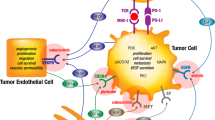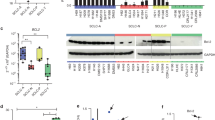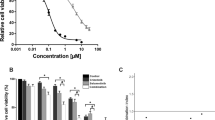Abstract
A panel of six 'wild type' and three VP-16 resistant small cell lung cancer (SCLC) cell lines is used to evaluate to what extent in vitro sensitivity testing using a clonogenic assay can contribute to combine cytotoxic drugs to regimens with improved efficacy against SCLC. The resistant lines include (a) H69/DAU4, which is classical multidrug resistant (MDR) with a P-glycoprotein efflux pump (b) NYH/VM, which exhibits an altered topoisomerase II (topo II) activity and (c) H69/VP, which is cross-resistant to vincristine, exhibits a reduced drug accumulation as H69/DAU4 but is without P-glycoprotein. 19 anticancer agents were compared in the panel. The MDR lines demonstrated, as expected, cross-resistance to all topo II drugs, but also different patterns of collateral sensitivity to BCNU, cisplatin, ara-C, hydroxyurea, and to the topo I inhibitor camptothecin. The complete panel of nine cell lines clearly demonstrated diverse sensitivity patterns to drugs with different modes of action. Correlation analysis showed high correlation coefficients (CC) among drug analogues (e.g. VP-16/VM-26 0.99, vincristine/vindesine 0.89), and between drugs with similar mechanisms of action (e.g. BCNU/Cisplatin 0.89, VP-16/Doxorubicin 0.92), whereas different drug classes demonstrated low or even negative CC (e.g. BCNU/VP-16 -0.21). When the CC of the 19 drug patterns to VP-16 were plotted against the CC to BCNU, clustering was observed between drugs acting on microtubules, on topo II, alkylating agents, and antimetabolites. In this plot, camptothecin and ara-C patterns were promising by virtue of their lack of cross-resistance to alkylating agents and topo II drugs. Thus, the differential cytotoxicity patterns on this panel of cells can (1) give information about drug mechanism of action, (2) enable the selection and combination of non-cross-resistant drugs, and (3) show where new drugs 'fit in' among established agents.
This is a preview of subscription content, access via your institution
Access options
Subscribe to this journal
Receive 24 print issues and online access
$259.00 per year
only $10.79 per issue
Buy this article
- Purchase on Springer Link
- Instant access to full article PDF
Prices may be subject to local taxes which are calculated during checkout
Similar content being viewed by others
Author information
Authors and Affiliations
Rights and permissions
About this article
Cite this article
Jensen, P., Christensen, I., Sehested, M. et al. Differential cytotoxicity of 19 anticancer agents in wild type and etoposide resistant small cell lung cancer cell lines. Br J Cancer 67, 311–320 (1993). https://doi.org/10.1038/bjc.1993.58
Issue Date:
DOI: https://doi.org/10.1038/bjc.1993.58
This article is cited by
-
Investigation of anti-cancer and migrastatic properties of novel curcumin derivatives on breast and ovarian cancer cell lines
BMC Complementary and Alternative Medicine (2019)
-
Target enzyme mutations are the molecular basis for resistance towards pharmacological inhibition of nicotinamide phosphoribosyltransferase
BMC Cancer (2010)
-
TIMP-1 gene deficiency increases tumour cell sensitivity to chemotherapy-induced apoptosis
British Journal of Cancer (2006)
-
Plasma Escherichia Coli β-Galactosidase as a Marker of Tumor Burden and Response to Experimental Anti-Neoplastic Therapy in Nude Mice Xenografted with lacZ Transduced Human Tumor Cells
Laboratory Investigation (2000)
-
Human cell lines as models for multidrug resistance in solid tumours
Cytotechnology (1993)



